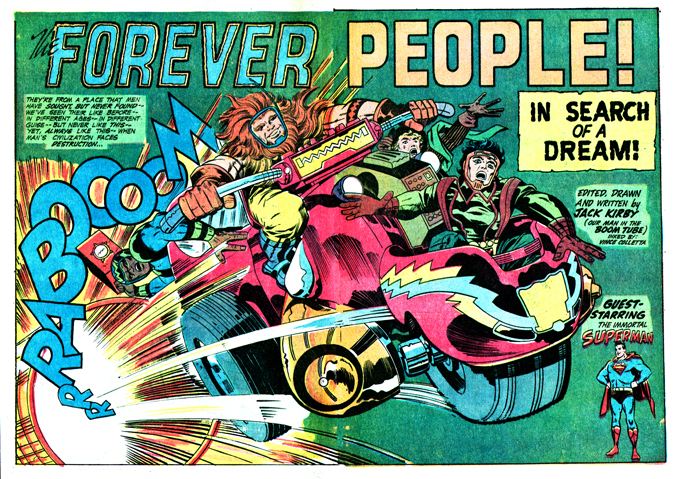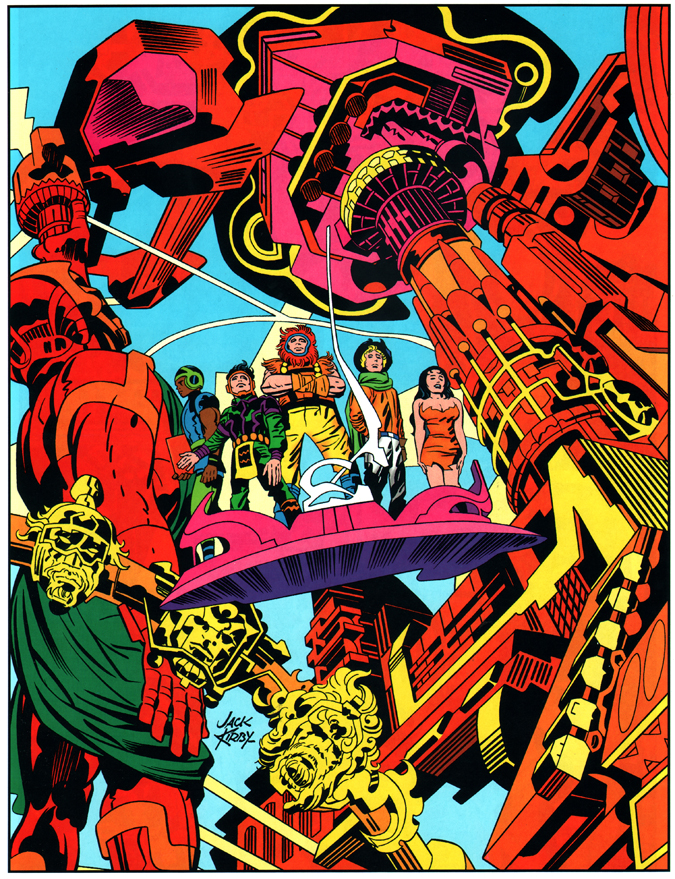Via the Boom Tube, riding the Super-Cycle, come the kids from Supertown (minus the female member), The Forever People, arriving for their debut adventure on planet Earth. The flower-power young people of New Genesis consist of [from left] Vykin the Black, Big Bear, Serifan, and Mark Moonrider… we’ll meet up with Beautiful Dreamer later in this story, as well as with two other integral “characters” very closely associated with the quintet.
The Forever People is Jack Kirby’s statement about his hope that the young people of his day, the hippies, would deliver the rest of us from a violent, selfish world. It’s remarkable, really, that Mr. Kirby, a middle-class workaday guy with a work ethic that would exhaust the puritans and other zealots, one saddled with a mortgage, home-making spouse, four kids and intensely demanding job, had such obvious affection for the Baby Boomer generation, by 1970 well into their twenties. Hippies were a huge demographic in the U.S., who (to wildly generalize) were virtually united against the Vietnam War, demanded the voting age be reduced to 18, heavily into drug use (particularly pot and LSD) and advocated free love. They also professed non-violence as a creed (though an active minority did engage in radical politics, some preaching the violent overthrow of government) and a curiosity for other world cultures. Nowhere was the hippy movement bigger than in the Golden State, where Jack and his family had recently moved.
Hippies also embraced one trapping of their younger years and seized it as their own: the comic book. Underground comix, originating out of the very heart of hippydom, the Haight-Asbury district of San Francisco, had huge distribution and astonishingly frank and explicit work was being published. And the mainstream work of Stan, Steve & Jack’s Marvel Comics was firmly entrenched in hippy culture, alongside the alternative funnybooks of R. Crumb, Gilbert Shelton and Rick Griffin. This, the Woodstock Generation, was receptive to Jack and vice versa…
It needs to be said, Jack also personally encountered any number of young people with increasing frequency. His street address and phone number were in the directory and The King (and Queen Roz) would welcome into their kitchen an endless parade of youthful pilgrims seeking an audience with the creator. Plus the fact the San Diego Comic Convention and other shows were being held so, perhaps for the first time, Jack had regular — and ever-growing — larger scale dealings with the longhairs…
Back to our subject: The Forever People may be the first super-hero group who is primarily non-violent (now, I’m not counting a certain infinite personage here, so settle down!). Their mission is to beat Darkseid to the discovery of the Anti-Life Equation and to end the Super-War between Apokolips and New Genesis. Their creed, as is all of Supertown, is “Life!!” and they live to protect and help others. We’ll discuss them as an entity in the days and weeks to come, but suffice to say they are an utterly original grouping in mainstream American comic books and, again, they are testament to Jack’s open-mindedness and empathy for the younger generation.
Mark Evanier has a particularly fine description of the kids in his Kirby: King of Comics biography:
“The Forever People featured the teenage gods, patterned after the youths that Kirby was observing all around him. In the midst of the Vietnam era, Jack was wholly on the side of those opposing Richard Nixon and the ongoing military action. He saw idealism, passion and a better future in them and sought to infuse his Forever People with the same hopes, the same sense of responsibility at inheriting a world made dangerous.”
I’ll be dealing with each character in the entries to come, so I’m going to feature an eloquent letter of comment regarding this issue, the first of The Forever People run, that appeared in #3:
Dear Editor:
Just to add a few words to the already awesome mound of praise (one might term it a “mountain of judgment,” had one a way with clever nomenclature) surely deluging you, my compliments on the first issue of Jack Kirby’s The Forever People. In recent memory only Deadman, Enemy Ace and Bat Lash seem to match this strip for innovation and success. Which probably means — if we are use as yardstick, the commercial failures of these high-water marks of quality continuity — The Forever People is too good for the average comic audience.
Its power and inventiveness display the Kirby charisma at its peak. Every panel is a stunner. Potentially, it appears to be the richest vein of story material National has unearthed in years. One hopes Kirby will be given total free rein, that he will be allowed to ride his dreams wherever they take him, for the journey is a special one, and we get visionaries like Kirby only once in a generation, if we’re terribly lucky. To constrain him, force him to fetter himself with the rules and rags of previous comics experience, would be to dull the edge of his imagination.
After the many false starts of National efforts in the past five years, at last it seems you’ve struck the main route. That it should be Kirby — at the top of his form — that worked point-scout, is not surprising. He has long been master of the form, and in The Forever People, it seems he’s found his metier.
Best wishes and prayers for a long, long life for The Forever People. Till now, all the flack bushwack about this being the Golden Age of Comics has fallen tinnily on us; but with Kirby in the saddle and The Forever People casting its wondrous glow, you now have leave to bang the drums.
— Harlan Ellison
Sherman Oaks, Calif.




Jon,
Thanks for the wonderful post. We don’t have to go by the book to know where Kirby’s heart was, as I noted previously, he threw a bunch of grapes out the window to support Caesar Chavez and advocated that his son, Neal, move to Canada to avoid the draft.
I was one of those kids who invaded the Kirby’s home uninvited. In fact, my “boss” was there asking Kirby to pay for a house number we’d painted on his curb. I protested to my friend (who ran the show), but Jack would have none of it and insisted on paying.
While my collector friend (who wasn’t even a fan of Kirby) went back to the car to collect a stack of comics Jack readily agreed to sign, I stood in Jack’s kitchen next to a table adjacent to the front door covered with comic books.
Not sure what to say and embarrassed, I stared slack-jawed until Kirby broke the silence.
“You’re probably disappointed. I bet you expected a big guy like the Hulk.”
“No, no, you are big; you’re a giant,” I blurted out.
I later wished I’d added, “It’s the comics which got small.”
Jack then took us all through his house showing us original art he’d hand-coloured in frames on his walls. At the back of the house, overlooking a swimming pool and a ravine beyond, Kirby showed us his drawing board. On it was the “mineral city” page from the 2001 Treasury Edition. On a small easel next to the board was a page from Kamandi.
Looking closely at the 2001 page, almost touching it with my nose, I said, “You’re recreated 3-D comics, but without the glasses.”
Gawd, isn’t that a beautiful adaptation? It’s funny, reading the Fourth World stories, one a night, how new and fresh it all becomes again for me. I mean, I’ve leafed through these tales hundreds of times in my life but to really READ them, to take the time like I give to prose fiction and perhaps with a more discerning and “mature” eye than I did as a kid greedily goobling up the comics off the racks, the material pulls me in deeper and deeper, and I find more resonance and meaning…
Kubrick and Kirby are in the same realm for me (that of genius in their respective fields), and with Stanley, too, I find more to ponder and marvel at as I gray with age. I used to think the director’s work as detached and almost dehumanized — cold, maybe — but now I see him as an almost unparalleled observer of human behavior, allowing what we SEE to be the story he is telling, perfectly utilizing the medium for what it is supposed to be. Barry Lyndon is the story of an idiot; but a feeling, involved HUMAN idiot and more evocatively told than most any other period piece. Kubrick is perhaps ANTI-manipulative. And it’s breathtaking to share in his view of the world and cosmos…